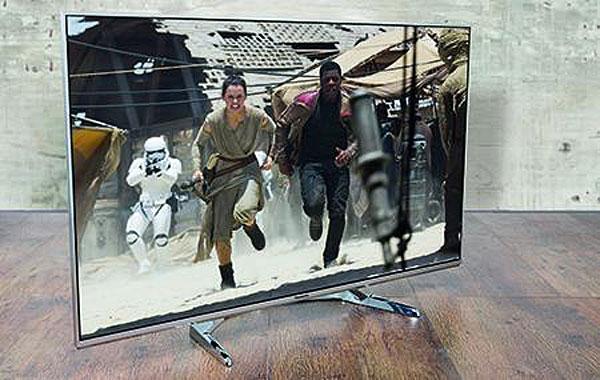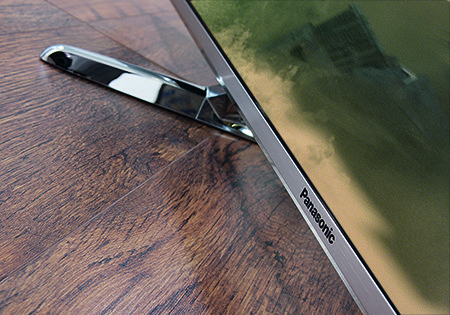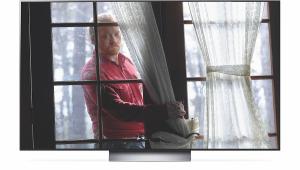Panasonic TX-50DX750 review


My immediate question is: can such an affordable set do HDR proud? The early signs aren’t entirely promising. Unlike the DX902, this screen fails to meet the criteria to wear an Ultra HD Premium badge. In brightness terms, it falls well short of the 1,000 nits required. Nor does its colour performance cover 90 per cent of the DCI-P3 colour range. The 50DX750’s 8-bit LCD panel isn't up to UHD Premium’s 10-bit demands, either.
What impact these limitations might have on its Ultra HD Blu-ray performance I'll get to later; first there are other features to highlight – starting with the set’s design. The 50DX750 looks elegant in its slender silvery way, and offers a degree of customisation. Adjustable desktop legs can be mounted with either their curved or angled sides facing forwards, and positioned either towards the centre of the screen or at its corners. This means you get a choice of four different stand options. It's a very clever piece of product design.
Connectivity is decent. Of the set’s four HDMIs, two support the HDCP 2.2 anti-piracy protocols and 4K/HDR streams at up to 60fps. There's a trio of USB inputs for playing multimedia from thumb-drives or recording from the built-in tuner. Also, of course, the 50DX750 carries Wi-Fi and Ethernet network options supporting home media streaming and smart TV fun. The latter includes access to the latest versions of Amazon and Netflix’s video streaming apps, complete with support for their 4K and HDR streams.
Catchup TV, meanwhile, is handled by the TV’s support of Freeview Play. Here, you can access shows you’ve missed on the main UK terrestrial TV channels via programme listings that scroll backwards seven days.
The 50DX750’s many content options are marshalled by Panasonic’s superb Firefox-based smart TV interface. This remains one of the most attractive, logical and personalisable smart hubs around.
The Master at workFor images, the 50DX750 carries the brand's new ‘Studio Master HCX’ video processing engine (but not the HCX+ version). This takes on special importance here given the challenges involved with ‘down-mapping’ HDR’s colour and brightness information/values to the screen’s specifications.

Compared with more high-end HDR TVs I’ve seen this year so far, there’s no doubt that this screen's HDR pictures don’t hit quite the same heights. At the same time, though, it does a better job than might have been expected.
For starters, you do get a sense of HDR’s greater dynamics. In the stunning Ultra HD Blu-ray transfer of The Revenant there are numerous bright highlights that impress. When Glass is finally found by his ex-trapper colleagues, the torches glowing against the night sky appear with markedly more intensity than they do in SDR.
Black levels look slightly deeper in The Revenant’s night-time scenes too, but more important than that is the way the 50DX750’s video processing retains a surprising amount of greyscale and shadow detail subtlety in dark areas. Shadow detail is one of the first things that usually goes AWOL when HDR’s luminance range is remapped to relatively limited brightness screens.
Occasionally, shots of Glass standing foregrounded against a very bright backdrop can see him start to look like a dark silhouette rather than a fully realised part of the image – but these instances are rarer than expected.
With HDR colour, the 50DX750 doesn’t proffer the same richness of tone as Samsung’s KS9000 or Panasonic’s own DX902. The blue skies and beautiful sunsets that emerge above The Revenant’s wilderness, or the flames of the film’s fires, don't carry that same level of impact and colour depth. There’s more potential for gentle colour banding in skin tones and skies, too. Yet everything still looks more richly coloured than the 1080p BD version.
HDR viewing also exposes a significant weakness, and one similar to the issue I have with Samsung's KS9000 rival. During extremely contrast-rich scenes (the torchlit search for Glass in the dark is a fine example) there were obvious vertical bands of light running down the image around its brightest parts. Once again, the blame can be laid at the edge LED lighting array.
This sometimes really distracting issue can be countered by turning off the set’s local dimming option, but then its black levels become so grey that they’re more annoying than the occasional ‘light bar’. The issue is less obvious if what you’re viewing doesn’t feature black bars above and below the image.
Getting back to the good news, the brightness, contrast and colour-boosting technologies Panasonic has introduced for HDR work wonders on standard dynamic range images. Black levels with the Blu-ray version of The Revenant look quite beautiful – largely free of greyness if you employ the local dimming system, yet also still full of depth and variance. Colours are crammed with subtle blends, helping visuals retain a naturalistic feel. Knock the set’s backlight setting down to below its 50 per cent mark (something you can’t do with HDR without reducing the accuracy of the screen’s HDR remapping) and dark sequences appear free of the backlight banding and other clouding issues evident if you leave it too high.
The DX750 features strong detailing with native 4K footage and refined HD upscaling. In fact, its performance with SDR footage (which most of us will still be watching for much of the time, especially when it comes to broadcast TV) is genuinely excellent. My only gripe is a little image softness when showing rapid motion.
As usual, Panasonic's Intelligent Frame Creation feature is an option to improve motion clarity.
The TV's 3D performance, meanwhile, is fair to middling. The brightness and colour response is strong, and the panel's impressive contrast helps create a tangible, enjoyable sense of space and depth. However, there's enough crosstalk around to take the edge off the 3D image’s sharpness and make long-term stereoscopic viewing quite fatiguing.
Pictures are accompanied by a 20W speaker system that manages to make dialogue credible and clear, and adds a palpable sense of space to The Revenant’s epic landscapes. There's even a reasonable amount of controlled, distortion-free bass.
OutnumberedPanasonic's 50DX750 is overall a pretty likeable mid-range 4K TV. Its SDR pictures are regularly a thing of beauty, the smart features are excellent, and its good HDR moments far outnumber its bad ones. Yes, it doesn’t deliver the full glories of the new dynamic video format – and as with other TVs this year has issues keeping its backlight in check – but it's priced accordingly. And what may stand most in its favour is its 50in panel size. Not everyone has room in their life for a 4K megascreen. This will find plenty of admirers.
Specification
3D: Yes. Active 4K: Yes. 3,840 x 2,160 HDR: Yes. HDR 10 Tuner: Yes. Freeview HD Connections: 4 x HDMI inputs; headphone jack; optical digital audio output; 3 x USBs; Ethernet port; integrated Wi-Fi Sound: 20W Brightness (claimed): N/A Contrast ratio (claimed): N/A Dimensions (off stand): 1,115(w) x 647(h) x 40(d)mm Weight (off stand): 16kg
Features: Studio Master HCX processing engine; HDR remapping; edge LED lighting with local dimming; Freeview Play built in; Firefox smart TV system (My Home Screen 2.0); 4K/HDR Netflix/Amazon support; 1800Hz BMR IFC; quad core processor; HDCP 2.2 support on two HDMI inputs
 |
Home Cinema Choice #351 is on sale now, featuring: Samsung S95D flagship OLED TV; Ascendo loudspeakers; Pioneer VSA-LX805 AV receiver; UST projector roundup; 2024’s summer movies; Conan 4K; and more
|

















































